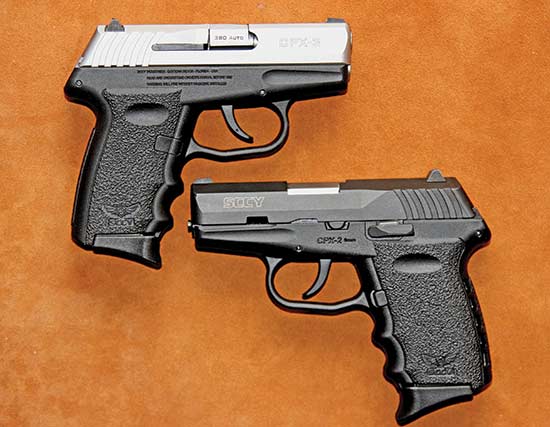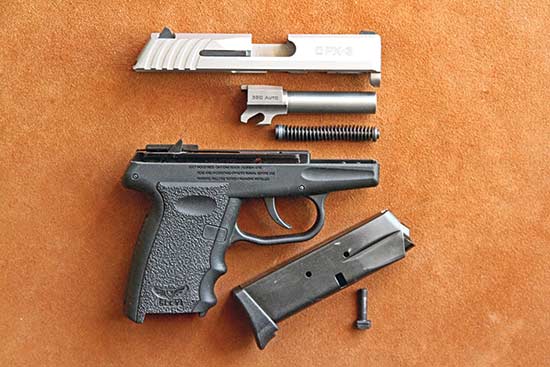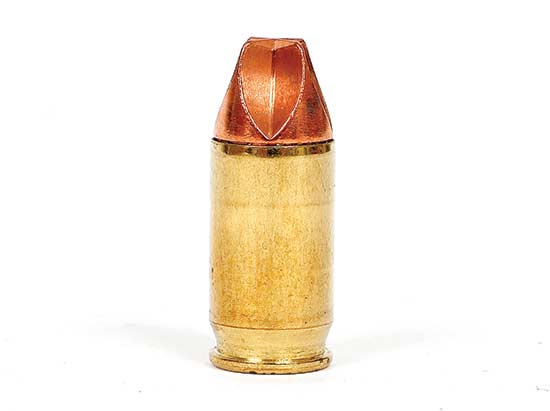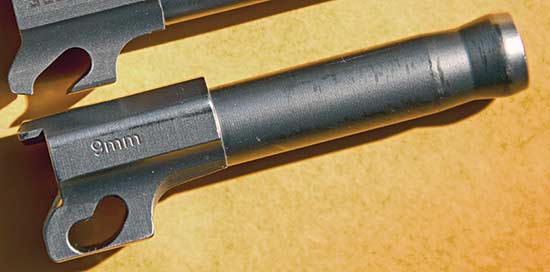Reach For The SCCY
Stone Simple And Economical, An Innovative American Handgun Company Has The 9mm/.380
ACP Bases Well Covered
The .380 ACP CPX-3 (top) is compared with the slightly larger 9mm CPX-2.
The 9mm version is slated to be upgraded with the Roebuck Quad Lock.
Has the defensive handgun race ever been so fast and furious? I think we can safely say no! This stampede is due to the election, the National Rifle Association and all of the new “gunnies” who have awakened to their Second Amendment rights.
This latter group consists in no small part of those men and women who were still in liquid form only a couple of decades ago. Yes, the future of America’s “Keep and Bare Arms” faction looks bright.
Not only are hunting, competition shooting and collecting blossoming, but also acquiring firearms for personal protection. A large part of this involves handguns and remains divided between revolvers and self-loading pistols. What’s a new gun buyer to do?
The Eternal Question
Traditionally, double-action revolvers have been recommended to new self-defense customers because they are simpler to operate. Double-action revolvers generally have only two widgets — one to open the cylinder and one to fire the gun, as long as the revolver is DA-only. If it has a hammer that can be cocked for single-action fire, the gun will either have to be fired or the hammer “safely” lowered, a problematic task without training.
The self-loading handgun has its own widgets to include a magazine release, requiring the slide to be pulled back and released to chamber the first round, not to mention that when the magazine is removed a loaded cartridge remains in the chamber. Oh, and perhaps there’s also a manual safety. On the other hand, all else being equal, self-loading handguns — being slimmer — are easier to carry concealed.
Comparing a double-action revolver to a self-loading pistol to a car with an automatic transmission to one with a stick-shift is sometimes the shortest way to direct a new handgun buyer to decide which direction to take, but not necessarily. There is also the comfort factor, hand strength and other considerations such as simplicity of operation, not to mention cost. Some self-loading pistols are simpler to operate than others and one is the subject at hand.
It’s the new CPX-3 from SCCY, makers of a very similar, but slightly larger SCCY pistol, the CPX-2. By the way, if you didn’t know, it’s pronounced “SKY.” As far as CPX goes, it’s a series thing, but “Compact Pistol X-tra” is closer to the truth.
The number “2” stands for 2nd Generation and it’s the extensive upgrade done to the pistol when Wayne Holt bought the company several years ago. All CPX-2 pistols are in 9mm and all CPX-3s are in 380 ACP. Other than the fact the CPX-2 here has a blue slide and the CPX-3’s slide is stainless, the two pistols may look identical at first glance. They’re not.
Disassembly
Fieldstripping SCCY pistols is pretty much a cinch. After removing the magazine and making sure the chamber is empty (nothing in its mouth and nothing to feed it), point the pistol in a safe direction. Then retract the slide all the way back while pushing up on the slide stop with your thumb and release it — the slide will lock back.
Now use the rim of an empty casing — or a similar tool — to insert down into the slot in the left side (head) of the slide-retaining pin. The slide will remain back when you release the slot. Pull the pin out, set it aside and, while holding the slide, depress the slide stop to free the slide to slowly go forward. The slide group can then be pulled off the front of the frame and the captive recoil spring can be removed for cleaning and inspection. Reassembly is in reverse order.
9 Long or 9 Short?
The 9mm CPX-2 is a hair taller and about 12mm (0.475″) longer than its new .380 sibling. Unloaded, the two are almost identical at 1.13 oz. for the 9mm and 1.12 oz., for the .380. The 9mm is also notably wider at 1.15″ while the .380 is 1.095″ at their widest points. Barrel lengths are 3.12″ for the 9mm and 2.96″ for the new .380.
Inside, the 9mm CDX has a double, opposite round recoil spring system and locking cross pin that is 0.0002″ longer than that of the .380, and both pistols have solid alloy fire control modules with full-length slide rails. Oh, yes, and both pistols have a 10+1 capacity. So, why have a .380 when for a little bigger pistol you can have a 9mm?
Good question. For one thing, the CPX-3 .380 is a little easier to conceal and more comfortable in smaller hands. And you can get an extended 12-round magazine. The felt recoil of the .380 ACP is also less than that of the 9mm. Well, you may say, this means the 9mm is better because it’s more powerful and has a lot more stopping power. Right? Mmm, not necessarily. There’s also more to it.
I know this is hard to swallow, but in studying thousands of shootings it has been shown caliber isn’t a major factor. No matter what the caliber, fast, accurate follow-up shots are what will allow you to survive in a gunfight. While I may be able to do just fine with a 9mm, my wife may not. The modern bullet technology has also allowed the .380 to close the performance gap between it and the 9mm, but to each his — or her — own.
Shooting, Handling, Accuracy
With the .380 SCCY the slide is slightly easier to withdraw for loading and the trigger pull is a tiny bit easier. I also found its narrower and smaller grip more comfortable. Loading both magazines presented no problem. In my opinion, both of these pistols could be recommended for personal protection out to 50 feet in the hands of an above-average shooter. Using a rest or going prone, an expert should be able to make body hits out to 25 yards, but at either a distance it would probably be more prudent to flee or dial 911 no matter what handgun you were armed with.
True double-action handguns with long trigger pulls are generally best used at no more than 15 yards when under stress to avoid “missile misses” especially when innocents are in the area. I found I could easily make good body hits at 50 feet standing and using a 2-handed modified Weaver hold. To check the accuracy potential of the CPX-3 .380 at this distance, I sat at the bench and — using sandbags — could produce 5-shot groups of 4″ at 50 feet. By comparison, with the 9mm CPX-2 about 5″ was as good as I could do. The good news is the 9mm SCCY should be redesigned with the CPX-3 Roebuck Quad-Lock upgrade by the time you read this. The only thing I’d change on these pistols is a wide notch rear sight, which can be handled by a competent gunsmith. By the way, these sights are steel, not plastic. And both the CPX-2 and CPX-3 are offered in a variety of colors — Black, Crimson Flat Dark Earth, Orange, Blue, Gray, Pink, Purple and White.
In addition to some old FMJ .380 ACP and 9mm, I tested both SCCY pistols with a few current loads, including Black Hills’ new HoneyBadger. There were no malfunctions and many of today’s .380 loads are right at the doorstep of the 9mm in velocity and gelatin tests. The HoneyBadger is particularly interesting, as it does not expand and has no need to. The solid copper bullet parabolic design not only penetrates tough barriers unscathed, but also travels 14″ into 10 percent ballistic gelatin, leaving an impressive temporary and permanent wound channel that would provide solid incapacitation to an adversary. From the 2.96″ barrel of my CPX-3, the 60-gr. HoneyBadger clocked 1,168 fps.
For a reliable and super priced ($299 MSRP) defensive or backup pistol, check out the SCCY CPX-3.
SCCY
Ph: (866) 729-7599
Email: [email protected]
https://www.sccy.com









